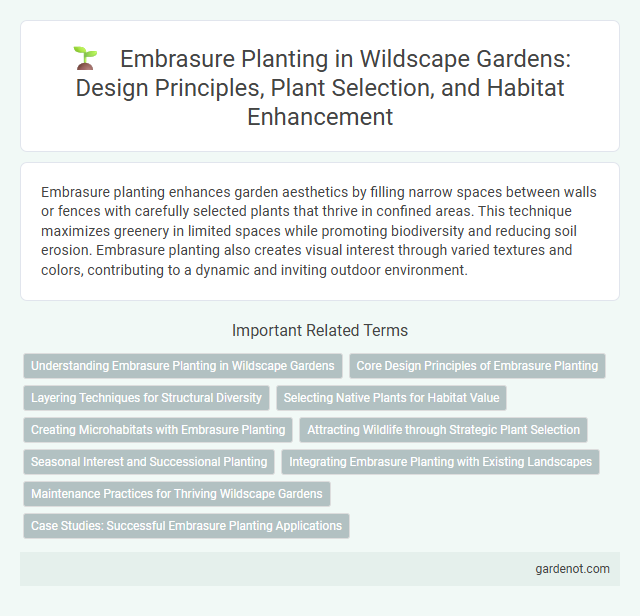Embrasure planting enhances garden aesthetics by filling narrow spaces between walls or fences with carefully selected plants that thrive in confined areas. This technique maximizes greenery in limited spaces while promoting biodiversity and reducing soil erosion. Embrasure planting also creates visual interest through varied textures and colors, contributing to a dynamic and inviting outdoor environment.
Understanding Embrasure Planting in Wildscape Gardens
Embrasure planting in Wildscape gardens involves strategically placing diverse native plants within gaps or openings between larger shrubs and trees to enhance biodiversity and habitat complexity. This technique promotes ecological balance by supporting pollinators, providing shelter for wildlife, and improving soil health through layered vegetation. Successful embrasure planting requires selecting species suited to local climate, soil conditions, and wildlife needs, ensuring a resilient and sustainable garden ecosystem.
Core Design Principles of Embrasure Planting
Embrasure planting emphasizes strategic plant selection and placement to enhance visual depth and structural complexity within outdoor spaces. Key design principles include layering diverse species to create naturalistic textures, maintaining sightlines through careful spacing, and integrating native plants that support local biodiversity. This approach balances aesthetic appeal with ecological function, fostering resilient, sustainable landscapes.
Layering Techniques for Structural Diversity
Embrasure planting employs strategic layering techniques to enhance structural diversity by integrating multiple plant species with varying heights and textures. This method creates dynamic vertical and horizontal plant layers, fostering habitat complexity and improving ecological resilience. Layered embrasure planting supports biodiversity by providing niches for a wide range of wildlife, contributing to a balanced and sustainable wildscape ecosystem.
Selecting Native Plants for Habitat Value
Selecting native plants for embrasure planting enhances habitat value by providing essential resources such as food, shelter, and nesting sites for local wildlife. Native species like milkweed, goldenrod, and coneflower support pollinators including bees, butterflies, and birds while promoting ecological balance. Incorporating diverse native plants strengthens ecosystem resilience and fosters biodiversity in wildscape environments.
Creating Microhabitats with Embrasure Planting
Embrasure planting involves strategically placing native shrubs and herbaceous plants within architectural recesses to create microhabitats that support diverse wildlife. These compact green pockets enhance shelter and foraging opportunities for pollinators, small birds, and beneficial insects, increasing local biodiversity. Incorporating species with varied bloom times and structures maximizes ecological benefits throughout the seasons.
Attracting Wildlife through Strategic Plant Selection
Embrasure planting incorporates native wildflowers, grasses, and shrubs to create habitats that support pollinators, birds, and beneficial insects. Selecting species like milkweed, coneflowers, and goldenrod enhances biodiversity and encourages natural pest control. Planting with seasonal variety ensures continuous food sources and shelter, optimizing wildlife attraction throughout the year.
Seasonal Interest and Successional Planting
Embrasure planting in wildscapes enhances seasonal interest by incorporating a diverse mix of native perennials, shrubs, and grasses that bloom and change color throughout the year, creating dynamic visual textures from spring through fall. Successional planting ensures continuous habitat value and aesthetic appeal by strategically overlapping bloom times and foliage changes, fostering a rich ecosystem that supports pollinators and wildlife across seasons. Selecting species with staggered flowering and fruiting periods promotes biodiversity and maintains ecological balance within the embrasure microhabitats.
Integrating Embrasure Planting with Existing Landscapes
Integrating embrasure planting with existing landscapes enhances biodiversity by filling gaps between established plants, creating seamless green corridors that support local wildlife. Strategic selection of native species ensures compatibility with surrounding flora, promoting soil stability and ecological balance. This method optimizes space while contributing to water retention and erosion control in wildscape environments.
Maintenance Practices for Thriving Wildscape Gardens
Embrasure planting in wildscape gardens requires regular pruning to promote healthy growth and prevent overcrowding, ensuring each plant receives adequate sunlight and airflow. Consistent watering schedules tailored to native plant species help maintain soil moisture without causing waterlogging or root rot. Mulching with organic materials suppresses weeds, retains soil moisture, and enriches the soil, fostering a thriving, sustainable wildscape ecosystem.
Case Studies: Successful Embrasure Planting Applications
Case studies of embrasure planting demonstrate significant improvements in urban biodiversity and air quality through strategic green space integration. In New York City, targeted embrasure planting around subway entrances reduced ambient temperatures by up to 5degC and increased native pollinator populations by 30%. Similar projects in London showcased a 25% reduction in noise pollution and enhanced pedestrian well-being in densely populated areas.
Embrasure planting Infographic

 gardenot.com
gardenot.com